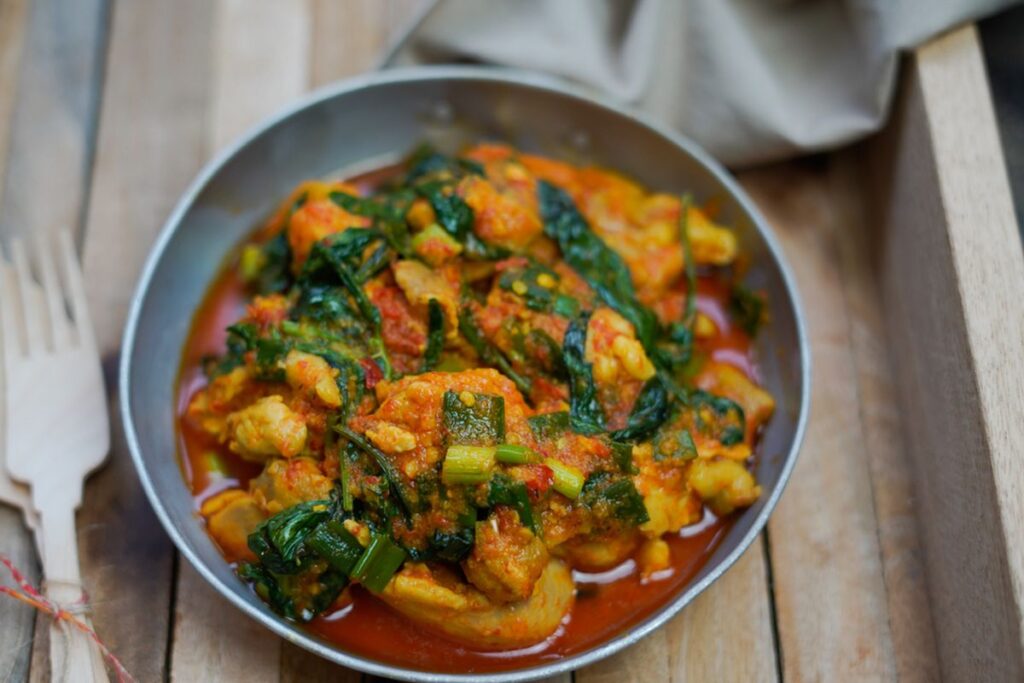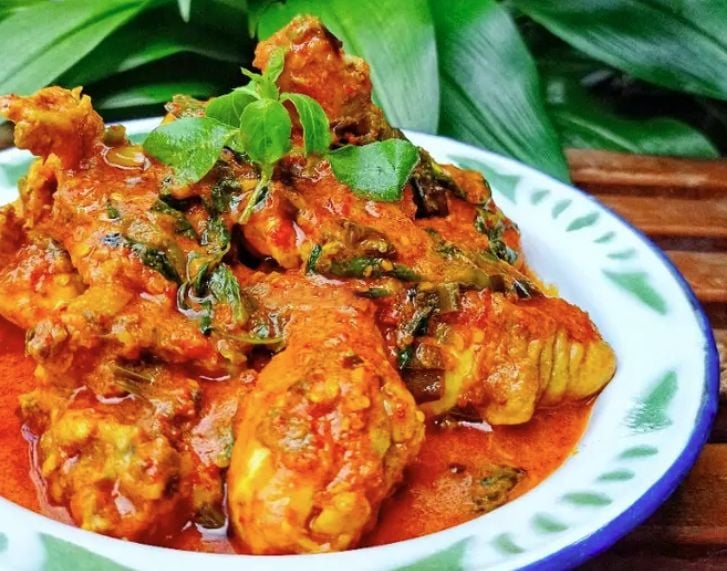Ayam Woku Kemangi is more than just a chicken dish; it’s a vibrant explosion of the tropical flavors and fiery heat that define the cuisine of Manado, North Sulawesi, Indonesia. This iconic dish—whose name simply means ‘Chicken cooked in Woku spice with Basil’—is a must-try for any culinary adventurer seeking bold, aromatic, and unapologetically spicy food.
The Origin: Manado’s Love Affair with Spices
The dish originates from the Minahasa people of North Sulawesi. The term “Woku” itself refers to a rich, complex spice blend and a cooking method, traditionally using a belanga (earthenware pot) or wrapping the ingredients in daun woka (woka leaves) and grilling them. The Manadonese palate is famously bold, prioritizing fresh, high-impact flavors, and Ayam Woku Kemangi is the perfect testament to this.
The Anatomy of the Flavor Bomb
What sets Ayam Woku apart from other Indonesian curries or stews is the sheer amount of fresh, aromatic leaves and the deliberate omission of coconut milk (in the classic version), resulting in a cleaner, brighter, and more intense taste.
The sauce is built upon a finely ground spice paste that includes:
- Heat: A generous quantity of chilies (both large red chilies and small, potent bird’s eye chilies) provides the signature fiery kick.
- Aromatics: Shallots, garlic, ginger, turmeric, and candlenuts form the savory foundation.
- The Leaves of Scent: The dish’s complexity comes from the essential “aromatic leaves” added whole: Kaffir Lime Leaves for a zesty perfume, Lemongrass for a citrusy depth, Turmeric Leaf (often used) for an earthy note, and sometimes Pandan Leaf for a subtle sweetness.
- The Star Finish: The dish is named after Kemangi (Lemon Basil), which is added right at the end. This fresh herb wilts slightly, releasing a unique, sweet, and bright citrus-basil aroma that beautifully balances the spice and heat.

The Cooking Process
Ayam Woku Kemangi is typically a slow-cooked, braised dish. The spice paste is first sautéed in oil until fragrant. Chicken pieces (often marinated with lime juice and salt) are then added and cooked down with the aromatic leaves and a little water. The cooking continues until the chicken is tender, and the sauce is thick, rich, and deeply absorbed into the meat. The fresh basil and sometimes sliced scallions are stirred in just before serving to maximize their fresh aroma.
The result is a tender, juice-filled chicken coated in a thick, reddish-orange sauce that is simultaneously spicy, savory, zesty, and intensely fragrant. It is traditionally served with hot steamed white rice, which is crucial for balancing the dish’s intense heat.
For those who love spicy food and crave an authentic taste of Indonesia’s Eastern flavors, Ayam Woku Kemangi is an unforgettable culinary experience that showcases the best of Manado’s rich, aromatic spice heritage.
Ayam Woku Kemangi (Spicy Basil Chicken) Recipe
This recipe captures the authentic, fiery, and aromatic flavors of Manado’s signature chicken dish.
| Prep Time | Cook Time | Servings | Spice Level |
| 20 minutes | 45-60 minutes | 4-6 | Spicy (Adjust chilies to taste) |
Ingredients
A. Main Ingredients
- 1 whole chicken (about 1 kg / 2.2 lbs), cut into 8-12 pieces.1
- 1 large lime or lemon, for marinating.
- 500 ml water or chicken stock (adjust for preferred sauce consistency).
- 4 Tbsp cooking oil.
- 1 large tomato, chopped into chunks.
- 2 large bunches (about 1.5 cups) Kemangi (Lemon Basil), leaves plucked.2
- 2-3 scallions/green onions, sliced diagonally.
- Salt and sugar/sweetener, to taste.
B. Whole Aromatics (Must be fresh!)
- 2 stalks Lemongrass, bruised/crushed (use the white base only).
- 4-6 Kaffir Lime Leaves, center veins removed and torn.
- 1 medium Turmeric Leaf (optional, but highly recommended for authenticity), tied in a knot.3
- 1 small Pandan Leaf (optional), tied in a knot.
C. Spice Paste (Bumbu Halus) – Grind until smooth
- 10 shallots (approx. 100g).
- 5 cloves garlic.
- 2-inch piece of ginger.
- 2-inch piece of fresh turmeric (or 1 tsp turmeric powder).
- 4 candlenuts (kemiri), lightly toasted/roasted (can be omitted if unavailable).4
- 6 large red chilies (reduce for less heat).
- 10-15 Bird’s Eye Chilies (cabe rawit) (reduce significantly or omit if you cannot handle extreme heat).
Instructions
1. Prepare and Marinate the Chicken
- Thoroughly wash the chicken pieces.
- Rub the chicken all over with the juice of 1 lime/lemon and 1 teaspoon of salt. Let it sit for at least 15 minutes. This step helps remove any “fishy” odor and tenderizes the meat.
- (Optional): For firmer chicken texture, you can quickly deep-fry the chicken until the outside is golden brown (but not cooked through) before starting the woku process.
2. Sauté the Spice Paste
- Heat 4 tablespoons of cooking oil in a large wok or deep pot over medium heat.
- Add the Spice Paste (Bumbu Halus). Sauté, stirring continuously, for about 5-7 minutes until the paste is deep red, fragrant, and the raw scent of the spices is gone. This is crucial for flavor.
- Add the Whole Aromatics (Lemongrass, Kaffir Lime Leaves, Turmeric Leaf, Pandan Leaf) to the paste. Sauté for another 1-2 minutes until their aroma is released.
3. Cook the Woku
- Add the marinated chicken pieces to the wok. Stir well, coating the chicken thoroughly with the spice paste. Cook for 3-5 minutes until the chicken surface changes color.
- Pour in the water/chicken stock. Bring the mixture to a boil.
- Season with salt and sugar/sweetener to taste. The flavor should be complex: spicy, savory, and slightly sour/fresh.
- Reduce the heat to low, cover the wok, and let the chicken simmer for 25-40 minutes (depending on the chicken cut) until the chicken is tender and the sauce has significantly thickened and concentrated.
4. The Final Aromatic Finish
- Once the chicken is tender and the sauce is at your desired consistency (usually thick and clingy), increase the heat to medium-high.
- Stir in the chopped tomato and sliced scallions. Cook for 1 minute until the tomato begins to soften.
- Add the star ingredient, the Kemangi (Lemon Basil) leaves.5 Stir quickly for only about 30 seconds until the basil leaves just wilt and release their intense, fresh aroma. Do not overcook the basil.
- Taste one last time and adjust seasoning if necessary.


Leave a Reply